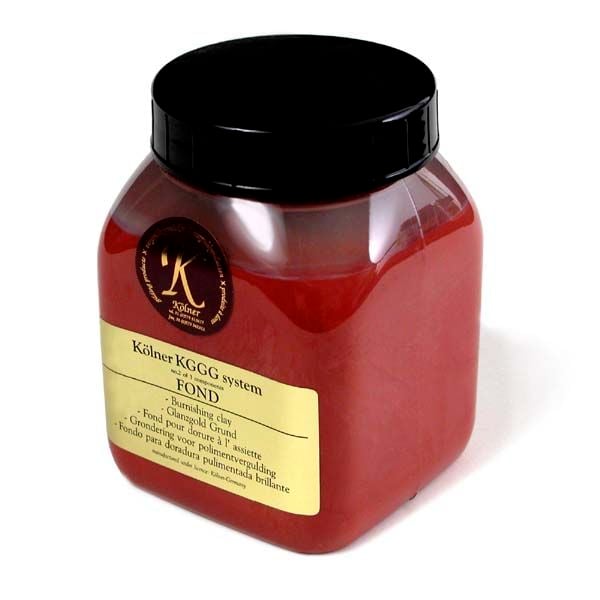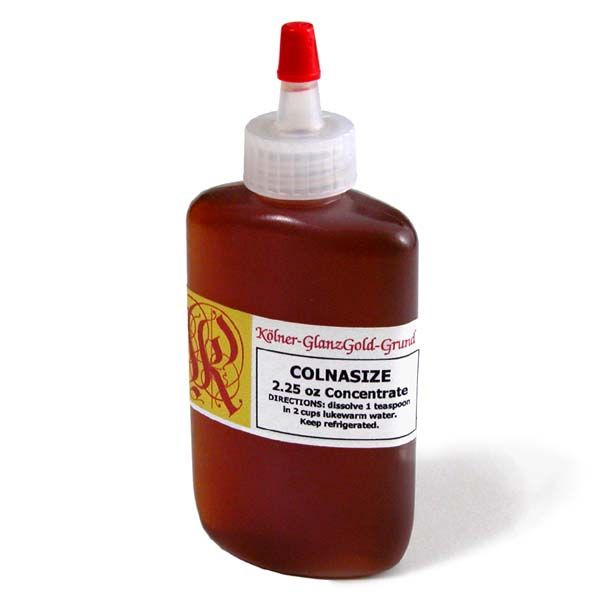

Kölner Colnasize
Kölner Colnasize is a concentrate and an easily prepared size designed for the adhesion of gold and silver leaf to Kölner Burnishing Clay and Kölner Insta-Clay.
Preparation
Dissolve one teaspoon in two cups of lukewarm tap or distilled water.
Some application techniques and climate conditions, such as low humidity, may require a stronger concentration. If initial tests do not produce the desired results, the concentration may be increased to two teaspoons per two cups of warm water. Tests should be conducted at various concentrations until the desired results are obtained.
Prepare the size in a clean glass container with a tight-fitting lid. Decant the amount you plan to use immediately. Don’t pour contaminated, used solution back into the original, pure solution. Uncontaminated, diluted Colnasize may be refrigerated for several days. Discard when the size has a foul odor.
Application
For best results, spray or brush with a soft, natural hair mop brush to apply an initial coat. Excessive surface tension may be reduced by adding up to 10% denatured alcohol and a couple of drops of glycerin. When the first coat is dry, apply a second coat by brush, flooding the surface to keep it wet until the leaf is laid onto the surface.
Apply the leaf rapidly while the surface is wet. A small brush will help apply size to faults or “holidays” in the gilding. Use small pieces of leaf to gild and patch.
Burnishing
Burnishing is a magical yet sensitive technique that requires careful observation and practice. This method involves gentle pressure, compressing the gold and the clay layers. You are aiming for a mirror-like reflection. If you try to burnish it too soon, the leaf will pull from the clay and have a dull appearance. Depending on temperature and humidity, you may wait as little as an hour and a half before beginning to burnish. Burnishing with the Kölner system generally requires gentler pressure than traditional water gilding.
Storage
Store Kölner Colnasize Concentrate and the prepared solution in a refrigerator.

Kölner Burnishing Clay
Preparation
All surfaces should be smooth, clean, and free of dirt, dust, or grease. Absorbent surfaces, such as matboard, paper, parchment, wood, textiles, unglazed ceramics, porous stone, plaster, traditional gesso or chalk ground, and compo, require a sealer before application of Kölner Burnishing Clay. High-quality dewaxed shellac may be used to seal. Primer-P is the recommended sealer and provides a strong bond between the absorbent surface, such as wood, and Kölner Burnishing Clay.
Non-absorbent surfaces require no sealer before application of Kölner Burnishing Clay: Plexiglas and other plastics, glass, sealed wood, non-porous paints, and metals (which may require primer). Other sealed surfaces and smooth metals may require light sanding to promote good adhesion.
Do not use Kölner Burnishing Clay over traditional water gilding without first applying a barrier coat of shellac. Do not use Kölner Burnishing Clay to patch chips in traditional water gilding, as the systems are incompatible over time.
Kölner Burnishing Clays are used at room temperature. Before use, they should be thinned slightly with water in the following ratios:
100ml (3.40z) Kölner Burnishing Clay add 0.25 oz of water
500ml (16.90z) Kölner Burnishing Clay add 1.25 oz of water
1 Liter (33.90z) Kölner Burnishing Clay add 2.50 oz of water
Stir the clay gently but thoroughly, avoiding air bubbles. Decant the amount of clay you plan to use immediately.
Application
Use a soft, natural hair brush to apply clay in long, flowing strokes in one direction. Allow each layer to dry thoroughly before the next coat is applied; the average drying time is half an hour. The color lightens and becomes matte when dry.
A minimum of three coats should be applied, and further coats may be desired. It is not necessary to sand between coats. Sand with high-quality emery, aluminum oxide, or wet/dry silicon carbide paper. Start with 400 grit and finish with 600 or possibly 800 grit paper. Dry sand only.
Burnishing
Burnishing is a sensitive technique that requires careful observation and practice. This method involves gentle pressure, compressing gold into the clay and gesso layers. There is a limited window of opportunity for burnishing. With practice, you will learn to gild only as much as you think you can burnish in a given time. You are aiming for a mirror-like reflection. If you try to burnish it too soon, the leaf will pull from the clay and will have a dull appearance. If you burnish too late, the leaf will crack or streak with inconsistent shine.
Depending on temperature and humidity, you may wait as little as an hour and a half before beginning to burnish. You may have only a short time to burnish. Burnishing with the Kölner system generally requires gentler pressure than traditional water gilding.














